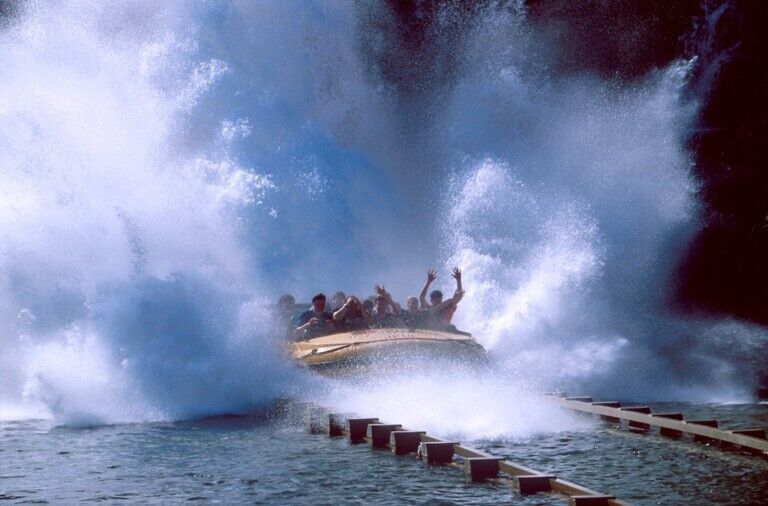Cloward H2O, an expert in aquatic design, has shared how it approaches water feature projects for theme parks, engineering for spectacle, emotion, and wonder.
Allen Clawson, P.E,. principal/managing partner at Cloward H2O, says:
“As an aquatic engineer, I’ve come to see water not just as a medium, but as a magic-maker. In the design of theme parks, water features can be far more than decorative flourishes. They are emotional anchors, visual magnets, and kinetic storytellers. They heighten immersion, pull guests into the narrative, and create moments of joy, awe, and discovery.
“Done right, they don’t just enhance guest experience—they define it.”
In addition, water can physically guide the guest experience. When used intentionally, it becomes a natural wayfinder, drawing people into plazas, marking transitions between themed areas, and subtly directing the flow of foot traffic.
Designing for the senses
What makes water so powerful in a theme park setting is its ability to engage multiple senses at once. The sound of splashes, cool mist, and rippling light are more than decorations- they are emotional cues that influence the ambience.
By engineering systems that choreograph water movement with sound, light, and scent, the team at Cloward can create immersive moments. Splash pads, dancing fountains, or water cannons offer delight, boosting dwell time, exploration, and overall atmosphere.
When guests interact with water, they’re not just cooling off—they’re participating in the story.
Cloward shares some ideas for integrated features in a theme park:
1. Set the scene
Water features reinforce a park’s theme, whether guests enter a tropical, futuristic, or ancient setting, helping sell the illusion.
When it comes to entrance features, elements such as large-scale fountains or reflecting pools can establish an immediate “wow” factor. These are ideal for grand entry plazas where guests first orient themselves.
Elsewhere, narrow streams or foggy mist corridors can be used to separate one themed area from another, giving guests a physical and emotional cue that they are entering a new world. For anchor attractions, dramatic waterfalls, kinetic water sculptures, or architectural water walls at major attractions can increase visual magnetism and draw guest traffic.
2. Create sensory-rich environments
Guests don’t just see water—they hear, feel, and sometimes smell it. Multi-sensory immersion deepens emotional engagement and creates lasting impressions.
For example, trickling creeks and bubbling fountains in quiet zones (e.g., garden paths, rest areas) can be used to encourage relaxation and contrast with high-energy zones. At the same time, water sounds in sync with ambient music or sound effects add narrative texture, especially effective near dark rides or jungle-themed areas.
Light mist jets at attraction entrances or in queues add a tactile element, especially in hot climates.
3. Design for interaction:
Interactive features turn guests from observers into participants. Interactivity encourages play, increases dwell time, and is especially popular with families.
Zero-depth splash pads with programmable jets and touch sensors are ideal for family zones, children’s lands, or near dining areas where parents can rest. Elsewhere, user-controlled water elements elevate queue lines or themed environments. For example, allow guests to trigger geysers or fire streams at passing ride vehicles.
Additionally, motion-sensor fountains can activate jets or mist in response to guest movement for surprise-and-delight moments.
4. Guide movement and organise flow
The team at Cloward also knows how to use water as a spatial tool to subtly guide where people go, how long they stay, and how they perceive transitions across the park.
For instance, designs can include water-defined pathways. Channels or reflecting pools define walkways and visual sightlines, naturally drawing people forward. Plus, visual transitions over water via bridges, stepping stones, or glass platforms are great for storytelling beats or photo ops.
Low walls and water features can be used to organise queues or restrict foot traffic without needing visible fencing.
5. Engineer showpieces
Signature fountains and water shows create iconic moments that anchor the guest’s memory and social media presence.
For nighttime spectacles, choreographed fountains with music, projection, and lighting are used as evening entertainment. Or, timed fountain shows in central plazas or near key attractions can create periodic crowd draw-ins.
Another idea is to install programmable water sculptures that blend art with motion.
More than decoration
Water features are more than decorations; they actively contribute to a park’s story, economy, and identity. They can boost guest satisfaction and dwell time, provide passive and active cooling, create moments of wonder, joy, and interactivity, guide movement and shape experiences, reinforce themes and narratives, and demonstrate a park’s commitment to innovation and sustainability.
Clawson says: “At the heart of every great theme park water feature is a perfect storm of artistry, technology, and intention. These features do more than look good—they invite wonder, provoke emotion, and enhance the journey. As aquatic engineers, we don’t just move water—we help shape experience.”
Cloward H2O also recently shared details of a project for Vidanta, a renowned global brand dedicated to environmental sustainability and offering luxurious vacation experiences.
